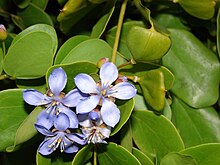Guaiac resin
Guaiac , gum guaiac also, Guajacum, the resin of different trees of the genus guaiac , mainly officinale Guaiacum L. and Guaiacum sanctum L.
Extraction
Guaiac resin escapes from the trunk by itself in small amounts; the yield from the living tree can be increased by cutting into the heartwood. Since the resin makes up 18-25% of the heartwood, it is also obtained by placing 1 m long pieces of wood drilled through the length at one end over the fire and collecting the resin flowing out at the other end in vessels below. It can also be obtained by boiling wood (flour) with salt water, the resin collects on the surface and can be skimmed off after cooling. Extraction with solvents and the purification of resin obtained in other ways is also possible. The main eligible areas are the Antilles and other Caribbean islands . It is usually sold in large chunks.
properties
By smoldering and boiling you get brittle, hard, dark green or reddish to black-brown pieces with shiny breakage, by incisions in the heartwood, hazel to walnut-sized grains that are dark red-brown and greenish on the outside. Crushed, they form red-brown, greenish, shiny, glassy splinters.
The resin obtained has a specific weight of 1.2 g / ml, melts at 85 to 90 ° C and smells like benzoin, especially when heated . It tastes sharp, scratchy and sticks to the teeth, dissolves in ethanol , isopropyl alcohol , diethyl ether , chloroform and alkalis with a brown color; alcoholic solutions take on a blue color when iron chloride solutions are added. Oxidizing influences, such as oxygen from the air, turn it blue or green; it is discolored by reducing substances or heating.
The resin consists of various lignanic acids, such as guaiaconic acid (C 19 H 20 O 5 ), which melts at 95-100 ° C and is temporarily colored blue by oxidizing agents. In addition, there are guaiacid and dihydroguayaretic acid and other lignans , as well as guaiacol (guaiac alcohol), guaiacol , vanillin and terpenes such as guaia gutin . 70% of the resin is soluble in diethyl ether and about 15% in petroleum ether , this portion containing the (dihydro) guajaretic acid. Among other things, dehydroguajaretic acid can be found in the diethyl ether extract. Other ingredients are 3.7% rubber and 0.8% mineral ingredients.
use
In Central America and the Caribbean countries of origin of the plant, the resin and wood are popularly used for skin diseases, gout and rheumatism, as well as syphilis. The resinous wood chips were swallowed by Central American Indians as a remedy against intestinal parasites. The resin is often used by the indigenous people of these regions as an incense and is used in healing ceremonies and rituals to drive away evil spirits.
Guaiac resin has only been found in pharmacies since the 17th century. Guaiac resin or wood was used as a sweat and diuretic agent for syphilis , rheumatism , gout , psoriasis , scrofula , bronchial catarrh . G. officinale was so intensively used against sexually transmitted diseases in its natural range that it was introduced to Spain for cultivation in 1501. In Europe it was used with mercury to treat syphilis, in the so-called Plummer pills for sore throats and was still part of the British Pharmacopoeia in 1990 as a remedy for chronic rheumatic complaints. It was also used in veterinary medicine as an antiseptic.
Paper soaked in an alcoholic guaiac resin solution diluted in a ratio of 1: 100 turns blue quickly and intensively due to oxidizing agents and is therefore used as reagent paper. This is the so-called guaiac reaction .
Guaiac resin is approved as a food additive. It is used as an antioxidant, among other things. After all, it plays an important role as a smoking and flavoring agent.
literature
- Lisa Takler: Volatile compounds and antimicrobial effects of selected resins and balms from A – J. Diploma thesis, Univers. Vienna, 2015, pp. 60–65, online . (PDF; 3.18 MB), from ubdata.univie.ac.at, accessed on November 1, 2016.
Individual evidence
- ↑ Guaiac wood / guaiac resin (guajacum officinale). Retrieved December 6, 2015 .
- ^ Meyers Konversations-Lexikon . 4th edition, 1888/90 ( online reference at retrobibliothek.de).
- ^ A b Jean Langenheim: Plant Resins: Chemistry, Evolution, Ecology, and Ethnobotany. Timber Press, 2003, ISBN 978-0-88192-574-6 , p. 447.
